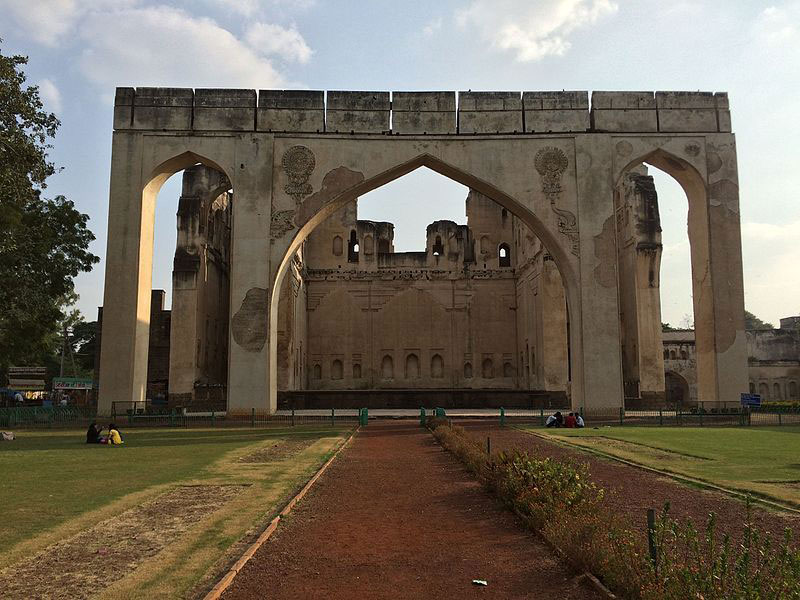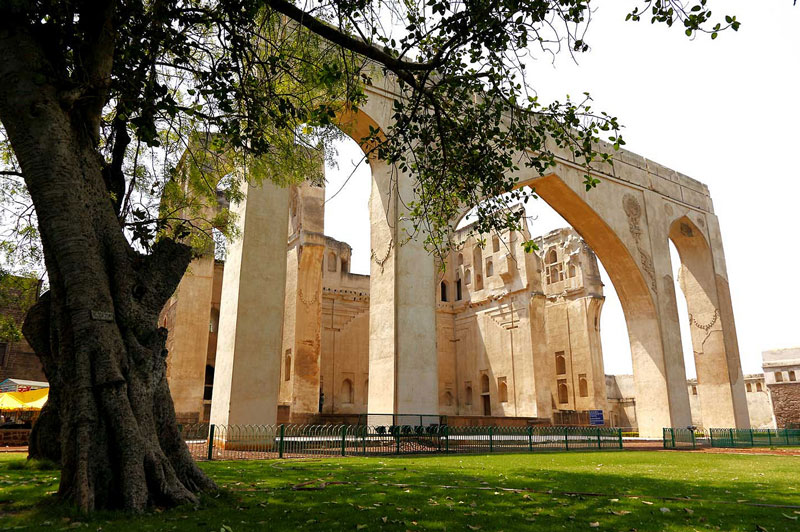Visitor Information
- Famous for: Sightseeing, Indo-Islamic Architectural Prowess, Historic Significance, Photography, Relaxing with Family, Experience Seeking and Wandering, Connoisseurs.
- Entrance Fee: Entry to this place is a meagre amount of Rs5 and camera fees are none.
- Visiting Time: From 8am to 6pm, this fort is pretty much open throughout the day inviting the wanderers to sit in its sprawling lawns and get a breath of archaic air with a beautiful view.
- Visiting Duration: Between 1 to 2 hours is the average time of duration that you might spend.
530 kilometers from the Karnataka State capital Bengaluru, the archaic city of Bijapur, or Vijayapura as it was once called is even today identified as the land where five rivers and a myriad of cultures confluence. Especially in the reign of Ali Adil Shahi, the areas around grew to become immensely powerful in terms of display of arts and architectural prowess. In an attempt to dislodge their predecessors’ showcase, the younger generations of kings would go on to develop more elaborate and architecturally humongous monuments and sculptures. The consequence of all this was massive opulent structures all over the Bijapur Fort (fondly called as the Gagan Mahal) and surroundings aptly called as the Agra of South India.
Traveler Tips
- Anegundi is often referred to as the ‘Sleepy Cousin’ of Hampi because of its quietitude and tranquility. But this may result in confusion among tourists as there is not a lot of active information being provided.
- For this reason, it is always recommended to visit this village with all the knowledge and awareness already in hand or only with a tour guide.
- Entry into the palace is also restricted so do not advent.
- Take some time in hand to admire and learn from the bejeweled windows complete with lattice work, the four towers with their amusing intricate carvings and the tall huge fort.
- In order to preserve the structures here, tourism has not been very active here, nevertheless there are a few really amazing sites to be visited in Anegundi and you should club your Hampi trip with a day at Anegundi.
- The vicinity to elephant stables by the palace, makes it another site to be visited.
- Do not carve your initials or draw onto the walls of this beautiful Indian Heritage. Help maintain it.
- Carry a cap, water bottle and some snacks when visiting here due to the overhead sun here and also the lack of food stalls anywhere near.
Things to Do
- Take a tour of the fort to absorb the architectural style and marvel at the culture of the Indo-Islamic.
- The artistic windows and wall carvings are a must see.
- Sit on the sprawling lawn with your family to have a nice time soaking in the royal feels.
Availability of Guides
Guides are available to walk you through but they are less in number so sometimes they might not be available. It is always recommended to look for one to learn most out of the structure.
Best Time to Visit
The months between October to February are the most pleasurable.
How to Reach
You first have to reach the village of Hampi in Karnataka. For this you have the option of flying to the Hubli Airforce Base Airport or the Bangalore Airport then continue on road. Either that or come till Hospet Railway station on a train then conitnue on bus/car.
The Gagan Mahal is at a distance of 3km from Hampi nestled in a teeny village called Anegundi by the embankments of Tungabhadra. There is only the option of private vehicles to reach Gagan Mahal or else traverse through the river on a boat.
Interesting Facts and Trivia About the Gagan Mahal
- The etymology of the word dictates that Gagan Mahal literally means a palace that touches the sky.
- Initially conceived as a court it, later transformed as a palace or durbar.
- According to history, Aurangzeb sent 50,000 soldiers to capture this majestic fort by emerging victorious over Sikandir Ali Shah. But they failed miserably due to the surpassing utilization of cannon batteries on both the facades.
- Afterwards, Aurangzeb himself came down, fought a gruelling 8 day battle and won.
- Built in the 16th century, has a sprawling lawn that holds capacity to seat thousands of praja at a time.
- The first floor is where the royal family resided.
- It was the tallest structure of its time at Bijapur.
- Most parts of the structure have been dilapidated. Except the main central arch, at 22 meters and the remaining 2 arches.
- This royal abode now functions as the building of the local Administrators.
- The finesse of the then engineers is noted by the structure of this palace. The walls remain cool even in peak summers.
- The fort’s front facade has also been a part of Indian postcards since long.
- There were pathways and staircases inside the fort that led to places from where the royal family could watch the ongoing spectacle on the courtyard, but in turn, they would remain safe and away from the sights of onlookers.

Nearby Attractions
- Matanga Hill
- Vithala Temple complex
- Elephant Stables
- Lotus Mahal
- Sanapur Lake
Nearby Restaurants
- Laughing Buddha
- Bamboo Restaurant
- Funky Monkey Restaurant
- Tibetan Kitchen
Plan a day’s excursion to this breathtaking proof of Adil shah’s prowess and soak in the heritage from here.


